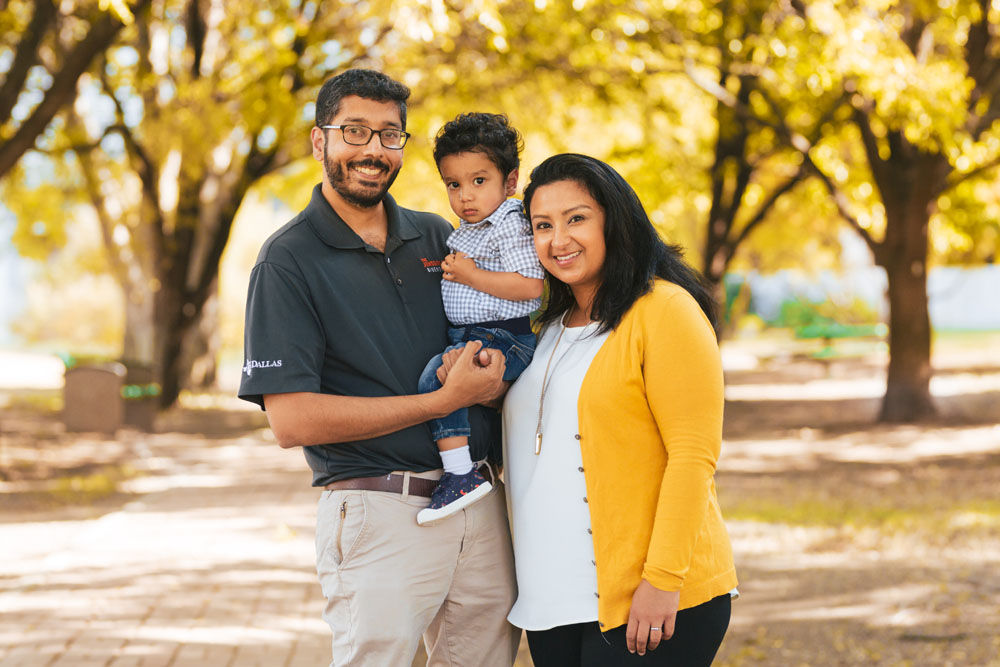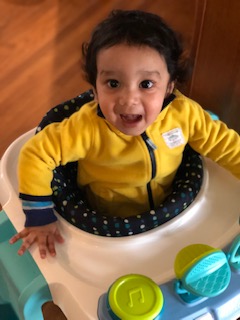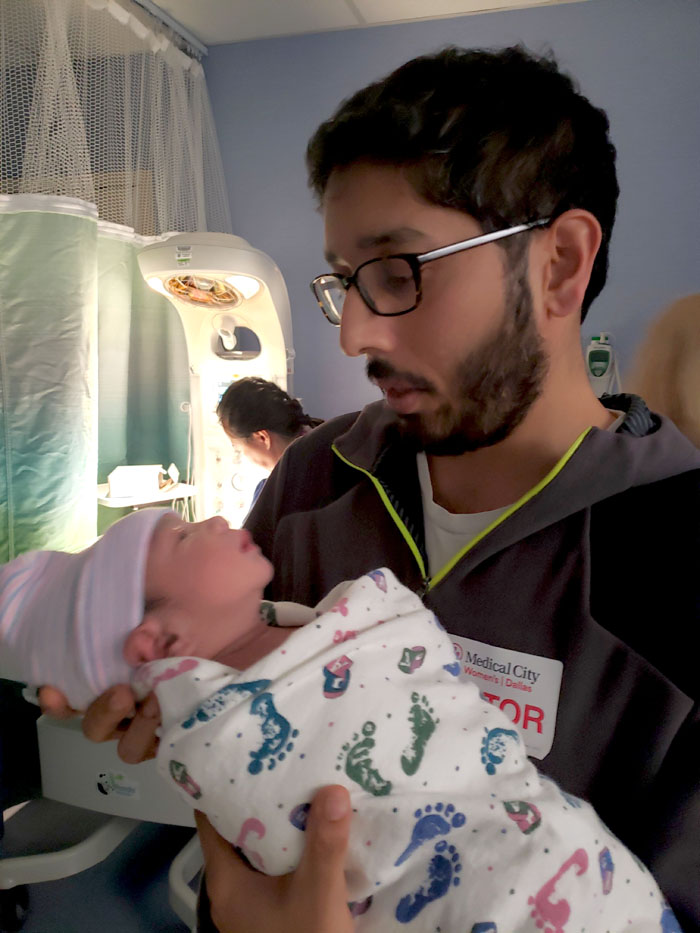Bioengineer’s Cancer Research Hits Close to Home with Son’s Diagnosis
By: Kim Horner | Oct. 27, 2021

J.D. was only 3 months old when the lump appeared on his abdomen last year.
An ultrasound showed seven lesions on the baby’s liver. Doctors told Dr. Shashank Sirsi, assistant professor of bioengineering at The University of Texas at Dallas, and his wife, Dr. Priya Joshi, a Dallas physician, that their son’s lesions were not necessarily abnormal.
However, more tests revealed that J.D. had neuroblastoma, a cancer that starts in immature nerve cells. The disease affects 700 to 800 children each year, according to the American Cancer Society.
Although neuroblastoma is rare, Sirsi already was familiar with the disease. As a researcher in the Erik Jonsson School of Engineering and Computer Science, he has studied a method to improve neuroblastoma treatment for more than a decade. His research is supported in part by more than $1 million in grants from the National Institutes of Health (5R01CA235756-03) to develop a novel method that uses ultrasound to help deliver medication directly to tumors. The co-principal investigator is Dr. Sonia L. Hernandez, research associate professor at The University of Chicago.
Until J.D.’s diagnosis, Sirsi’s experience with neuroblastoma was only in the lab and anecdotally through collaborating physicians.
“It’s a very strange position to be in, having studied this disease for quite a long time, and having the awakening and realization that in over 10 years that I’ve been in this field, I’d never met a neuroblastoma patient. It had all been theoretical for me,” Sirsi said. “The odds of being a researcher in this field and also being the father of a patient are mind-boggling.”

Doctors diagnosed J.D. with neuroblastoma MS, which meant that his tumors had metastasized and spread to the liver. The condition, however, is a lower-risk form of the disease — it has higher cure rates than other forms of neuroblastoma.
J.D. was not eating or gaining weight, which meant that the tumors on his liver may have been blocking his gastrointestinal system. At their doctors’ recommendation, the couple made the difficult decision to try chemotherapy to shrink the tumors.
Just as the new parents were dealing with their baby’s health crisis in spring 2020, the COVID-19 pandemic added new worries about J.D.’s health, since the treatment would make his immune system especially vulnerable.
Doctors inserted a port in J.D.’s chest to administer the chemotherapy. Children typically tolerate chemotherapy well. However, like many chemotherapy patients of all ages, he lost his hair and experienced nausea. The treatment worked. After two cycles, J.D.’s tumors had shrunk 75%.
“He’s a champion; he handled his chemotherapy very well,” Sirsi said.
While J.D. was going through treatment, Sirsi and Hernandez published a major paper about their research on neuroblastoma treatment using focused ultrasound. The research, published in July 2020 in the journal Theranostics, demonstrates a novel method that uses microbubbles to help deliver a nanoparticle-based chemotherapy directly to a tumor. In addition to the NIH funding, the research was supported by the Pediatric Cancer Foundation.
Transforming Research
To learn more about how UT Dallas is enhancing lives through transformative research, explore New Dimensions: The Campaign for UT Dallas.
Microbubbles are sound-sensitive, gas-filled spheres smaller than 10 micrometers that implode when exposed to ultrasound. This implosion can temporarily widen gaps in blood-vessel walls to allow drug-carrying nanoparticles circulating in the blood to escape at the precise location of a tumor. Therapeutic drugs and genes can also be loaded on the bubbles’ surfaces and released at the tumor site. The researchers use ultrasound imaging to guide and monitor the drug delivery in real time. The goal is to reduce the amount of medication needed, which would result in fewer side effects.
More research will be needed before the method becomes an option available to patients.
Watching his son go through chemotherapy gave Sirsi a new perspective on what neuroblastoma patients experience. He became concerned about the amount of anesthesia that J.D. received during treatment and how that could impact his developing brain.
“I’ve definitely become more clinically focused on how neuroblastoma patients are actually treated,” Sirsi said.

“Until J.D. was diagnosed, there were a lot of things I didn’t think about from a scientist’s perspective about what these kids have to go through. This has been an awakening, a learning experience and something that’s going to help guide my research for the rest of my life.”
Dr. Shashank Sirsi, assistant professor of bioengineering in the Erik Jonsson School of Engineering and Computer Science
J.D.’s port was removed in February, just before his first birthday. He is in partial remission, with tumors that are expected to go away on their own, which is characteristic of the type of neuroblastoma he developed. Doctors will monitor the tumors regularly going forward.
Sirsi and his family are grateful for good news these days: J.D.’s most recent scan was negative for cancer. J.D. is walking and babbling nonstop and meeting the milestones for his age. One of his first words was “Google,” influenced by the Google home device that plays his music. J.D. enjoys opening and emptying cupboards and watching the rabbits that visit his backyard.
“His prognosis is great,” Sirsi said. “This is the best-case scenario for kids with neuroblastoma.”
Sirsi continues to work toward better therapies for the potentially deadly disease. He and his team currently are using nonviral gene therapy approaches on hard-to-treat tumors. In addition, Sirsi recently began working with Dr. Baowei Fei, professor of bioengineering and the Cecil H. and Ida Green Chair in Systems Biology Science, to develop better ways of using focused ultrasound to target and treat metastatic neuroblastoma.
The researchers also are exploring the use of augmented reality to guide therapy. For example, they have sponsored a UTDesign senior capstone team to develop a clinical system that can superimpose real patient imaging data so doctors can see tumors in the body and apply ultrasound treatment.
“High-risk neuroblastoma cure rates are getting better, but it is still a deadly disease,” Sirsi said. “Until J.D. was diagnosed, there were a lot of things I didn’t think about from a scientist’s perspective about what these kids have to go through. This has been an awakening, a learning experience and something that’s going to help guide my research for the rest of my life.”
Media Contact:
Kim Horner, UT Dallas, 972-883-4463, kim.horner@utdallas.edu, or the Office of Media Relations, UT Dallas, (972) 883-2155, newscenter@utdallas.edu.





